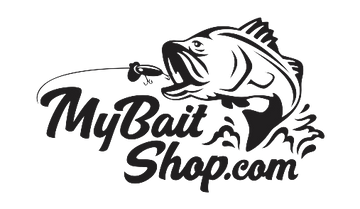Practice Casting Weights
Practice Casting Weights
It is not known exactly when the sport of casting actually began but it can be tracked all the way back to the 1860's when the New York Sportsmen's Club held their first fly tournament. The first bait casting competition wasn't introduced until 1883. In 1881 Robert B. Morston editor of the Fishing Gazette in London organized England's first casting tournament. Next the casting sport spread throughout many European Countries and around the world as far as Japan.
In 1907 the National Association of Scientific Angling Club (NASAC) was formed in Kalamazoo, Michigan. Since then there has been a national tournament nearly every year. By the 1930's tournament casting had become a legitimate and popular sport. Open tournaments for professionals and amateurs were held regularly by the NASAC. Sometime around 1938 the NASAC changed it's name to the National Association of Accuracy Casting Competition (NAACC). Most of the official weights were now marked NAACC.
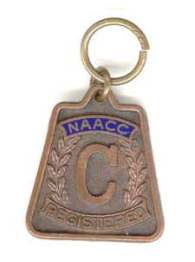 |
NAACC Class Casting Metals The NAACC ranked casters by classes. They would classify groups of caster by A, B or C caster. They had metals for each class and stamped the class A, B or C in bold on the metal front. |
After World War II sport casting grew considerably and many of the U.S. military personnel serving in Europe competed in casting tournaments. It soon became apparent to American and European casters that uniform rules were needed for the success of international competition. In 1953 the NAACC sent out invitations to numerous casting clubs asking them to join the proposed International Casting Federation (ICF). The proposal was very well received and Myron C. Gregory was elected president of the International Casting Federation (ICF). The constitution and rules were developed and in 1957 the first World Casting Tournament was held in Kiel, Germany.
Tournament Casting Medals were given to winners of each casting competition. There was different competitions such as casting for distance, casting for accuracy, fly casting, dry fly casting, etc. This (OASAC) first place medal was given to the champion caster for fly distance by the Ohio Association of Scientific Angling Club. The Association of Scientific Angling Club metals were utilized from c.1920 until 1938.
This Ohio Association of Scientific Angling Club (OASAC) 1st place metal was won by C. E. (Eddie) Braddon of Cleveland, Ohio. Mr. Braddon was the National All Around Casting Champion of the United States in 1927, 1928, 1935 and 1936.

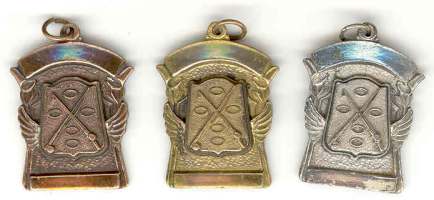 |
Casting Metals - Set of three casting metals from c.1950 |
In the early days of casting the clubs did not have any rules regulating the amount of weight the caster would use. These early casters mostly used frogs or two to three inch minnows. Later on as weight regulations were being established lead weights were starting to be used. It wasn't until the early 1900's that American tackle company's began making casting weights. These casting plugs were ideal for casting on lawns or casting pools. Many lure company's such as Heddon, Shakespeare, Pflueger, Creek Chub and South Bend made Practice Casting Plugs. Starting in their 1906 catalogue Heddon gave instructions for choosing the correct rod, reel, line, bait and specific instructions for learning to cast.
The 1902 Shakespeare Tournament Frog was designed for practice, exhibition and tournament bait-casting. Shakespeare was advertising competition for accuracy and distance tournaments in their 1902 catalogue. It was painted to exactly resemble a real live frog. This frog was the standard weight and shape and has been adopted as official by most of the leading bait casting clubs in the country.


Sample Casting Plugs
Heddon - Heddon first advertised a casting weight in their 1913 catalogue. They were made of wood, covered with white porcelain enamel and were available in either 1/4 or 1/2 ounce. The Heddon casting weights had an advantage over the aluminum casting weights because of their white color that could be easily seen at a distance. Heddon designed their casting weights to have minimum air resistance and countersunk the eye to prevent the line from fouling.
Heddon also made a series of practice plugs that were painted red and had a decal of a bass or trout on the side of the plug. This red casting plug was produced c.1910 and is extremely rare and difficult to find.







| 5/8 oz. Weight | Shake speare 1/2 oz Early | 5/8 oz. Official Varmac NAACC | 5/8 oz. Official Varmac NAACC | |
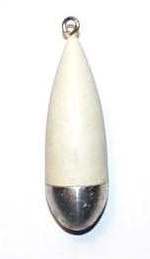 |
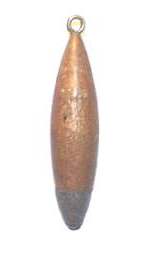 |
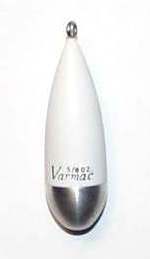 |
 |
|
| 5/8 oz. Weight | 5/8 oz. ACA Weight | Shake speare 3/8 oz | 5/8 oz. Weight | |
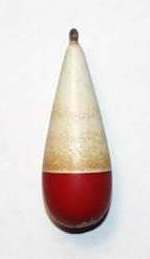 |
 |
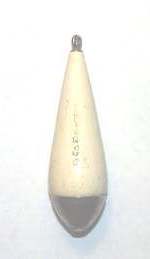 |
 |
|
| Creek Chub 5/8 oz 1939-1952 | Creek Chub 5/8 oz 1939-1952 | Shake speare 3/8 oz | ACA Approved | |
 |
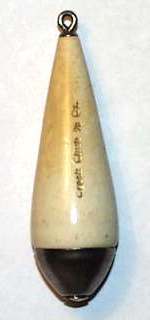 |
 |
 |
|
|
1947 P & K Tenite | 5/8 oz. NASAC | Pelcan - Inter national Tackle Co. | |
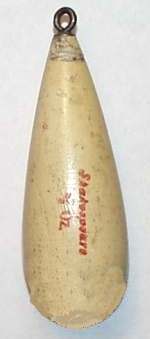 |
 |
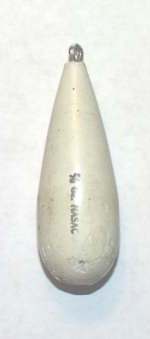 |
 |
1921 -1926 Early South Bend Practice Plug
his rare early South Bend Casting Weight is 4" long. It was made from the #973 Bass Oreno blank before the head was fluted. It was painted white and had one lead weight. The lead weight was the same as a belly weight used for their bass lures.
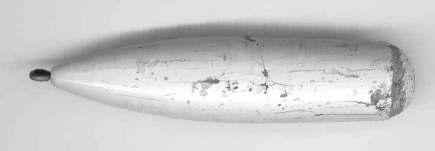
Definitions
- ICA = International Casting Federation
- NASAC = National Association of Scientific Angling Club
- NAACC = National Association of Accuracy Casting Competition
- ACA = American Casting Association
- OASAC = Ohio Association of Scientific Angling Club
- CACC = Chicago Angling and Casting Club
A special thanks to Mr. John Seroczynski president of the ACA & CACC for his information that helped complete this page.
My Bait Shop Updates:
If you have any further information on any of the items displayed on this page which you'd like to share, please send your comments to me and I'll update the page accordingly. Contributions of interesting items and/or unknowns are encouraged.
© 2024, My Bait Shop, LLC
